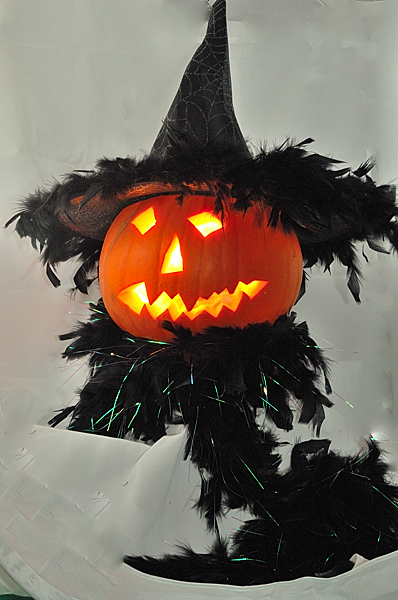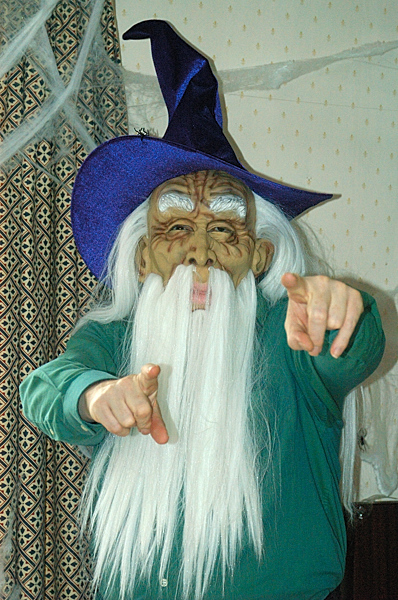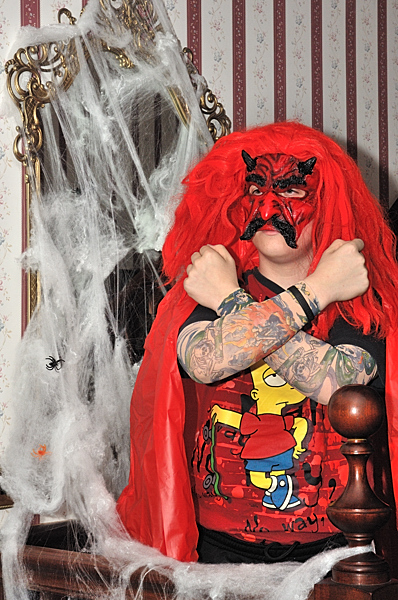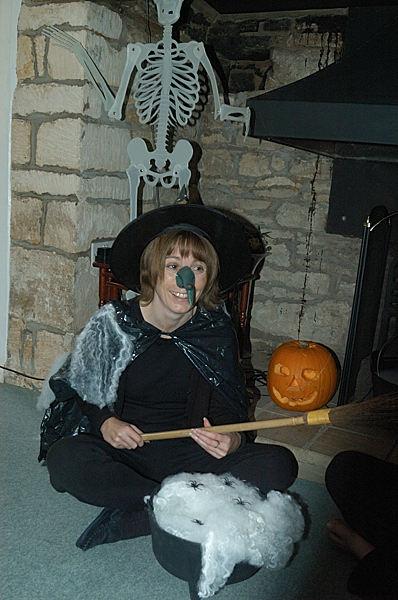| Throughout Britain as well as across the USA
and much of Europe Halloween is second in popularity to Christmas. For some the
fact that it happens over a single day, with limited commercialisation beyond
fancy dress sales and hire, makes it their favourite festival of the year. Quite
a lot of people who dislike Christmas enjoy Halloween. In this article we
are going to explore the history, traditions, games and what happens
today. For the photographer its a fantastic
opportunity, but also one where you need to balance your interest in
photographing it with your enjoyment of the fun with others. Following Halloween
why not have a go at photographing the now disused carved pumpkin in an
imaginary way.
The history
Halloween is the 31st of October, and has been since the
year 836 in England. Originally from this point in the Christian calendar known
as 'All Souls' Eve. It became known as All Hallows' evening, and over
time this was shortened to Halloween. Far before that it was a special day
in the ancient Celtic Calendar know as 'Samhain'. The word 'Samhain' is the Irish
Gaelic word for November and 't-Samhain' is the Scottish Gallic word for November.
There are variant spellings amongst these and other Gaelic cultures.
It is not, as some believe, an American
tradition but one that went from Europe to the states and was very
popular here in olden times. In more recent times it has become a far
wider celebration in the USA before being picked up in a large way again
here. In both the USA and UK, as well as many other places Halloween has
been growing very rapidly in popularity with many of us now enjoying
Halloween far more than Christmas.
It is also a huge industry, in the USA costume sales for
Halloween was $4.96 billion in 2006, up significantly from just $3.3 billion the
previous year. Between 2001 and 2006, consumer spending in the UK for Halloween
rose tenfold from £12million to £120million.
In the far past the year was divided into two parts the
dark part and the light part. With the year starting with the dark part, which
started on the 1st November. In many ancient beliefs the gap between something
is very important, and where spirits can inhabit or come through, so the Oak
tree with its loose bark and gaps was particularly important to ancient druids,
and the gap between one year and the next on 'Samhain', all souls evening,
Halloween, was the time when spirits from beyond this life could visit.
Providing some good but also being feared by some as well. It also allowed
futures to be told.
At this time stock was taken of livestock and food
supplies, the harvest was complete and decisions needed to be made about how
many animals should be kept alive through the winter period. Animals that were
not going to be able to be fed were slaughtered and their meat dried or smoked. The
fire that was used for this was the only one in the village, all others having
been put
out, and then as a part of this celebration all re-lit from this common fire,
signifying that the village was one, sharing warmth and food. In many cultures
there were two fires and both people and animals to be kept, went between them as
a part of a purification routine. This was the historic basis of all the fire
festivals, and accounts for why in many cultures they start around this time. In
Britain we celebrate bonfire and fireworks night on the 5th November, marking a
celebration of the prevention of catholic terrorists blowing up the King and
parliament.
Trick or treat came from a traditional festival
on the 4th November in Northern England called Mischief Night. Around the world
it's known by many names and occurred on either 31st October or 4th November,
Wikipedia
has an article on Mischief night
 . At the
beginning of the light half of the year you have another mischief like day on
1st April, April fools day. . At the
beginning of the light half of the year you have another mischief like day on
1st April, April fools day.
Spooks and Costumes
Halloween, is the boundary
between the end of one year and the beginning of the next, in this gap the alive
and the deceased dissolved, and the dead become dangerous for the living by
causing problems such as sickness or damaged crops. The festivals would
frequently involve bonfires, into which bones of slaughtered livestock were
thrown. Costumes and masks were also worn at the festivals in an attempt to
mimic the evil spirits or placate them.
The jack-o-lantern,
originally came about in Europe, with a turnip hollowed out, creating a lit
face, this was as a form of protection keeping spirits away from your home or you, if
you carried it. Later with the availability of the pumpkin, this was used,
as it was larger and easier to hollow out.
Believing that the head was
the most powerful part of the body containing the spirit and the knowledge, the
Celts used the "head" of the vegetable to frighten off any superstitions. The
name jack-o'-lantern can be traced back to the Irish legend of Stingy Jack, a greedy, gambling, hard-drinking old farmer. He tricked the devil into climbing
a tree and trapped him by carving a cross into the tree trunk. In revenge, the
devil placed a curse on Jack, condemning him to forever wander the earth at
night with the only light he had, a candle inside of a hollowed turnip.
Halloween imagery largely
developed through the cinema portrayals in horror movies, they tend to involve death,
magic, or mythical monsters. Traditional characters include ghosts, ghouls,
witches, owls, crows, vultures, pumpkin-men, black cats, spiders, goblins,
zombies, mummies, skeletons, and demons.
Games and other traditions
There are several games
traditionally associated with Halloween parties. The most common is dunking or
apple bobbing, in which apples float in a tub or a large basin of water, the
participants must use their teeth to remove an apple from the basin. A variant
of dunking involves kneeling on a chair, holding a fork between the teeth and
trying to drop the fork into an apple. Another common game involves hanging up
treacle or syrup-coated scones by strings, these must be eaten without using
hands while they remain attached to the string, an activity which inevitably
leads to a very sticky face.
Some games traditionally
played at Halloween are forms of divination. In Puicíní (pronounced "poocheeny"),
a game played in Ireland, a blindfolded person is seated in front of a table on
which several saucers are placed. The saucers are shuffled and the seated person
then chooses one by touch. The contents of the saucer determine the person's
life during the following year. A saucer containing earth means someone known to
the player will die during the next year, a saucer containing water foretells
emigration, a ring foretells marriage, a set of Rosary beads indicates that the
person will take Holy Orders (becoming a nun or a priest), a coin means new
wealth, a bean means poverty, and so on.
|







 |